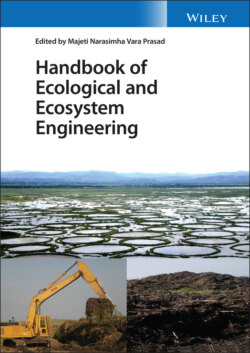Читать книгу Handbook of Ecological and Ecosystem Engineering - Группа авторов - Страница 41
3.4.2 Mangrove Restoration
ОглавлениеMangrove forests are integral parts of coastal ecosystems of ecological importance; 69 species of plants are referred to as mangroves. Mangroves cover 146 530 km of the world's tropical shorelines [16]. Reports witnessed a significant decline in the area of mangroves from 198 000 km in 1980 to 157 630 km in 1990, and it continues to decrease at a noticeable rate [16]. This loss is taking place primarily in countries like the Philippines, Thailand, Vietnam, Malaysia, and the US (Florida and Puerto Rico)[24]. A large re forestation program for the restoration of anthropogenic degradation caused to mangrove forests by planting Sonneratia Apetala species over an area of 1600 km2 on the accreted muddy shores of Bangladesh was successfully implemented with the aim of providing sufficiently raised land for accretion of sediments to support agriculture and vegetation. It has been estimated that about 800 km2 of land has been recovered as a result of these plantings after a loss of almost 50% caused by cyclones and insect outbreaks [4]. However, several similar attempts have failed to restore the mangroves in other countries. Nevertheless, a thorough study of the habitants and meticulous projection of ecological engineering projects will lead to successful restoration of mangroves, ensuring the coexistence of modern civilization with Nature.
Mangroves are intertidal forests along the shorelines of tropical regions, submerged under seawater most of the time and physiologically adaptable to saline water. The trees have special adaptations in their roots that let them survive in soft muddy soil and transport oxygen from the atmosphere to their roots in anaerobic conditions. Reproduction is supported by the unique nature of their seeds, which can float on water and are transported to other sites.
Mangrove forests naturally stabilize shorelines by reducing tidal currents and wind energy hitting the shore. They provide food and shelter to the coastal fish and shellfish colonies; habitat for various species of sea birds as well as wading birds; and timber, medical products, and useful chemicals (Figure 3.2). In spite of being home to a wide range of flora and fauna, mangroves are often considered worthless swamps and have been destroyed by hydrological impacts over the years. A major reason for mangrove die‐backs is annual hypersalinity variations caused by rainwater and freshwater flow. Although mangrove forests are known to undergo self‐repairing or secondary succession every 15–30 years; they can perform this self‐sustenance only if the tidal hydrology is not disturbed and the flow of floating seeds is not interrupted.
The need to restore mangroves was only been realized toward the end of the twentieth century. Traditional ecological restoration of these forests initially aimed at rehabilitation or management of natural resources such as planting timber‐producing trees. However, this approach is not the same as an ecological restoration process. For ecological restoration of mangrove forests, several aspects must be taken into consideration: a cohesive ecosystem, alternate stable state of the ecosystem, and development of a new ecosystem once the ecological threshold is crossed. Although a complete restoration of mangroves may not be practically viable, the objective is to minimize the difference between the undisturbed (may be naturally disturbed) and restored states of the ecosystem that correlate to the principle of [3, 48]. Common manipulation practices exercised during restoration to revitalize the ecosystem primarily include the following:
Figure 3.2 Schematic representation of the geographical distribution of mangrove biodiversity.
Source: Adapted from Biswas et al. [3]. © 2009, Springer Nature. See colour plate section for colour representation of this figure.
Structural manipulation: Tree planting and hydrological engineering designs
Compositional manipulation: Seeding and planting numerous species, enhancing diversity and habitat recovery
In addition to trees, land, and water, humans are considered the fourth component of the mangrove ecosystem due to their undeniable interference in most parts of Southeast Asian countries. Therefore, ecological engineering principles can be further manipulated by incorporating significant social and economic issues related to coastal environments and ensuring active participation by local communities along with supporting their livelihoods.
